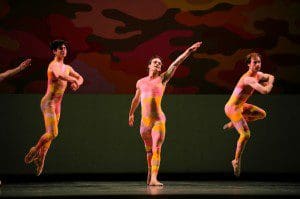
The San Francisco Ballet’s Program 2, which finished its run late last month, started strong. Wayne McGregor’s “Chroma” — one of three works making up the program — looked more like contact sport than ballet, an effect strengthened by the horn-and percussive-heavy, action-film score by Joby Talbot and Jack White III. MacGregor was not trained in classical ballet, and his choreography diverges from the classical in several refreshing ways. Ballet’s traditional “lift”—the illusion that the dancers do not share our subjection to the laws of gravity—was tossed out. The dancers seemed to revel in their weightiness, often moving in ways emphasizing horizontal rather than vertical lines. Pas de deux resembled the alternately combative and aggressive sexual grappling between equally powerful forces, rather than the stylized chivalry of the traditional male-female duets. It was exciting and sometimes scary, and the only bad call was the costuming—loose mini bandeaux in flesh tones that obscured the dancers’ waistlines and gave the impression they were wrapped in giant dental dams.
The costuming was one of several problems with the world premiere of Mark Morris’s “Beaux.” The commissioning of fashion designers, whose interest in or knowledge of dance and theater is debatable, to costume ballets has backfired several times, notably in Karl Lagerfeld’s 2009 restyling of the English National Ballet’s “The Dying Swan.” By placing an extra ruff at the collar (disrupting the line of the neck, almost as heinous a crime to commit against a ballerina as a swan) and constructing the tutu to sit too high on the waist (again breaking the line of the body), Lagerfeld’s prestige project won praise in the fashion world but incurred mostly wrath from ballet critics and audiences. Isaac Mizrahi seems similarly blinkered with regard to the difference between clothing a body that is basically a showcase for the clothes and clothing a body to enhance that body’s lines and movement in a way that is legible in a large auditorium. The men in the cast of “Beaux” wore shiny unitards colored in splotches of pink, green, blue, and yellow, a camouflage for lurking unnoticed in Macy’s flower show. They danced near-invisibly against a backdrop of the same pattern. Already subtle, the delicacy of the movements—Morris tends to eschew the showier acrobatics other choreographers often employ when devising works for men—was often lost against the noise of the visual elements. Ushers brought each of the men bouquets as they took their bows, which would be fine on the first night of a world premiere. But this was after the work’s true premiere, making it a somewhat gauche gesture, considering none of the other dancers, men or women, got the same treatment at the finish of their respective performances that night.
Christopher Wheeldon’s “Number Nine” somehow got lost in the evening, despite its cheery color palette and Michael Torke’s upbeat score (1989’s Ash). While there were standout pas de deux by principal dancers, including Yuan-Yuan Tan, the lack of cohesion in the corps de ballet that SFB sometimes suffers from reduced the visual power that unified movement can bring to a piece, which might have helped “Number Nine” establish its aesthetic more solidly. At only 16 minutes long, it was finished before I felt I had a chance to learn its language, so to speak, and I left not quite having grasped what I had just seen.

2 thoughts on “Dressing the Parts: S.F. Ballet’s Program 2 — ‘Chroma,’ ‘Beaux,’ and ‘Number Nine’”